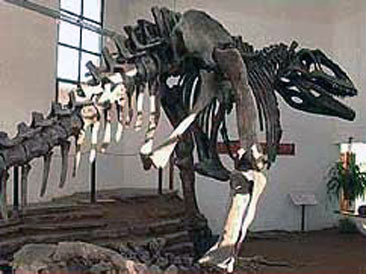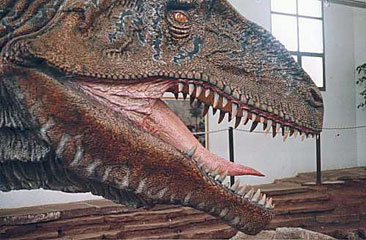Giant's land See map
The studies and dinosaur findings in the area
Dinosaurs are among the most successful organisms on Earth of all times, to have a reign that lasted more than 150 million years until their mysterious disappearance 65 million years ago.
Some of the world's most spectacular findings are from Patagonia, and especially of Villa El Chocón, city of Neuquen province, born from the construction of the hydroelectric dam of the same name.
 Giants of old times in Villa El Chocón.
Giants of old times in Villa El Chocón.Studies in the town began in 1987. In that year the paleontologist Jorge O. Calvo and geologist César Gazzera from the Natural Sciences Museum of the National University of Comahue, conducted a major icnologico study in the region.
This same investigation led to exhume and examine three important dinosaurs: the Ribachisaurus Tessonei, the Andessaurus Delgadoi, primitive dinosaur about 15 meters long (reported by a resident of the Villa, Alejandro Delgado) and Limaysaurus.
Ruben Carolini In 1993, a resident of El Chocón, starred in an amazing discovery. It is about the largest carnivorous dinosaur of all time, bigger even than the Tirannosaurus Rex. This new dinosaur has been studied by two paleontologists in the region, calling Carolinii Giganotosaurus: "giant southern lizard" and as second name the one of his discoverer.
The dinosaurs, whose footprints were preserved in the rocks around the lake Exequiel Ramos Mexia, lived 105 million years ago. In those ancient times the area of El Chocón-Pichi Picún Leufú was a relatively flat area in which there were gaps in shallow but of very long extension, united perhaps by slow-flowing rivers.
The warm and humid climate with dry seasons, probably subtropical, gave the landscape a desert look very different from which presently stands. On its banks there was a varied and numerous fauna of dinosaurs, crocodiles, turtles and frogs, which could have been permanent residents of the area.
A national historic site
 Copy of a "dino" in the Municipal Paleontological Museum of El Chocón.
Copy of a "dino" in the Municipal Paleontological Museum of El Chocón.In 1997 a law declared "national historic site" to "Valley of the Dinosaurs". The area declared historic is bounded on the north by the intersection of National Route 237 and access to the village and dam El Chocón; on the south by the intersection of that route and access to the town of Picún Leufú; on the east by shoreline of the lake margin Exequiel Ramos Mexia, and on the west by an imaginary line parallel to the coastline at five kilometers of it.
Over 65 milion years open their way into the mysterious underground around El Chocón. The erosion of the cliffs carved an undulating desert, full of stones and bones, that hides a treasure without equal in the world, 'the valley of the dinosaurs".
There is also a petrified forest, which covers over 120 hectares with 1,200 trees that are about 100 million years.
Discoveries
Some of the fossils so far have been found under these red soils are:
- Ribachisaurus Tessonei
- Andessaurus Delgadoiel Argentinosaurus
- Unenlagia Comahuensis
- Giganotosaurus Carolinii. It is the most important discovery in the region (July 1993), the largest carnivorous theropod known to date, and whose replica is at the Museum of Natural History in New York.
The Villa El Chocón allows research and tourism ensuring the preservation of these priceless assets that the land hide inside it.
Viajes por la Patagonia
Related Articles
© Patagonia.com.ar 2026 | Todos los derechos reservados.
